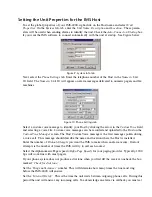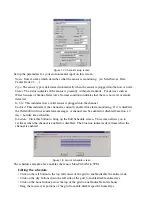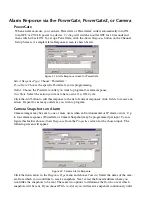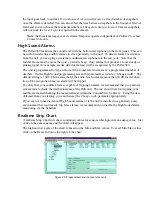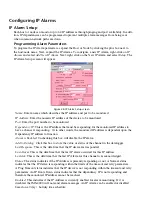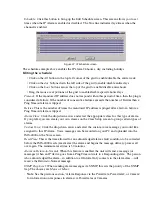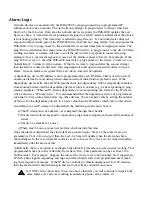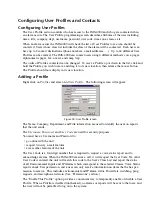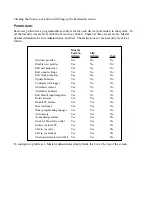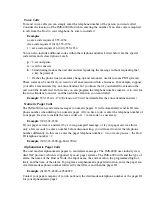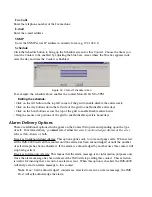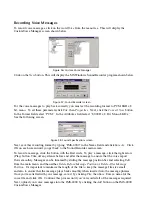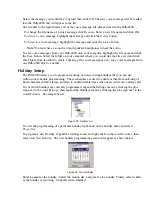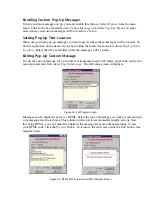
Alarm Logic
Network devices are monitored by the IMS-4000 by pinging/connecting to programmed IP
addresses about once a minute. The unit will only attempt to ping/connect to devices which are
Enabled
by the
Schedule
. Each time the network device responds, the IMS-4000 updates the
Last
Response
time. A time limit for responding is assigned to each IP Alarm to determine if the device
is functioning properly. This time limit is called the ping
Timeout
. If a network device does not
respond within this time period, the IMS-4000 will count this as a ping failure. You can program the
IMS-4000 to try to ping/connect to the network device several times before tripping an alarm. The
ping
Retries
determines how many times the IMS-4000 will try to ping/connect to the device before
sending an alarm. An alarm will only occur if the device fails to respond to consecutive ping
attempts. Once a successful response is received, the failure counter will reset. For example: If the
ping
Retries
is set to 3, then the IMS-4000 must fail to ping/connect to the device 4 times in a row
(initial a 3 retries) to trip an alarm. If the device were to respond after the second attempt,
then the failure counter would reset, thus requiring four subsequent successive failures to trip an
alarm. Once an alarm is recognized, the
Last Alarm
time will be updated.
A dependency device (IP address) can be programmed for each IP Alarm. This is used to prevent
numerous alarms from occurring when common network infrastructure problems arise. If the
dependency device fails, then all IP alarms that have this dependency will be temporarily disabled
from sending alarms until the dependency device returns to normal (e.g. starts responding to ping/
connect requests). When an IP Alarm’s dependency is not responding, the status for the IP Alarm
will be shown as “IP route down.” It is recommended that the dependency device be programmed
such that it will go into alarm before any other devices. You can achieve this by setting the number
of
Retries
for the dependency device to a lower value than the IP Alarms which rely on this device.
In summary, for an IP Alarm to be dispatched, the following criteria must be met:
a) The IP Alarm must be enabled—as configured through the schedule.
b) It must have failed to respond to consecutive ping/connect requests and exceed the number of
retries.
c) It must be a member of a class.
d) There must be one or more user profiles which include this class.
Once the alarm is dispatched, the alarm delivery process begins. If any of the contacts are pro-
grammed as
Until Acknowledged
, then the
Last Ack
time will update when the alarm has been
acknowledged. In the case where all contacts are set to
Inform Only
, the
Last Ack
time will update
immediately after the alarm occurs.
Additionally, there is an option to re-dispatch the alarm if it remains in an alarm state too long. This
programmable time period is called the
Alarm Reset Time
. This parameter can be set from 30 to
3600 minutes. For example: Suppose the
Alarm Reset Time
is set to 180 minutes. Now suppose an
IP device has stopped responding and trips an alarm which results in all programmed users receiv-
ing their respective messages. If the IP device continues to remain unresponsive for 180 minutes,
then the alarm will be dispatched again and everyone will be contacted once more.
DO NOT set the
Alarm Reset Time
too short, otherwise you will continue to dispatch the
same alarm over and over resulting in numerous phone calls, e-mails, etc.
IMS-4000 Manual
58
Summary of Contents for Sensaphone IMS-4000
Page 1: ...IMS 4000 User s Manual Version 2 4 8 PHONETICS INC SENSAPHONE ...
Page 44: ......
Page 59: ......
Page 60: ......
Page 102: ......
Page 106: ...IMS 4000 Manual 106 ...
Page 135: ...Chapter 7 IMS 4000 Sensors 135 ...
Page 146: ...IMS 4000 Manual 146 ...
Page 148: ...IMS 4000 Manual 148 ...
Page 158: ...IMS 4000 Manual 158 ...
Page 159: ...159 ...


